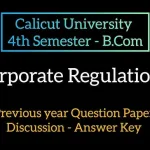The 11 Commerce question paper of 2018 covers various subjects important for students in the commerce stream. These include topics from subjects like Accountancy, Economics, Business Studies, and Mathematics.
11th Commerce Question Paper 2018 For All Subjects
Accountancy Questions and Answers
Question: What is the meaning of double-entry accounting?
Answer: Double-entry accounting is a system where every transaction is recorded in at least two accounts, with one debit and one credit.
Question: What is a journal entry?
Answer: A journal entry is a record of a business transaction in the accounting system, showing the accounts affected and the amounts.
Question: What is the purpose of a trial balance?
Answer: The purpose of a trial balance is to ensure that total debits equal total credits in the ledger.
Question: Define a ledger.
Answer: A ledger is the principal book where all transactions are summarized from the journal for a particular account.
Question: What is a bank reconciliation statement?
Answer: A bank reconciliation statement is a document that matches the balance of the company’s bank account with its financial records.
Question: What are financial statements?
Answer: Financial statements are formal records of the financial activities and position of a business, including the balance sheet and income statement.
Question: What is the accrual basis of accounting?
Answer: The accrual basis of accounting records revenues and expenses when they are incurred, regardless of when cash is received or paid.
Question: Explain depreciation.
Answer: Depreciation is the reduction in the value of an asset over time, due to wear and tear or obsolescence.
Question: What is a cash book?
Answer: A cash book is a financial journal that contains all cash receipts and payments, including bank deposits and withdrawals.
Question: What is the accounting equation?
Answer: The accounting equation is: Assets = Liabilities + Owner’s Equity.
Question: What are prepaid expenses?
Answer: Prepaid expenses are payments made in advance for goods or services to be received in the future.
Question: What is a balance sheet?
Answer: A balance sheet is a financial statement that shows the company’s assets, liabilities, and equity at a specific point in time.
Question: What is the purpose of a profit and loss statement?
Answer: The purpose of a profit and loss statement is to show the company’s revenues and expenses over a period, indicating profit or loss.
Question: Define goodwill in accounting.
Answer: Goodwill is an intangible asset that represents the value of a company’s brand, customer relationships, and other non-physical assets.
Question: What is inventory valuation?
Answer: Inventory valuation is the method used to assign a monetary value to a company’s inventory.
Question: What is a capital account?
Answer: A capital account records the owner’s or shareholders’ equity in the business.
Question: What is the difference between gross profit and net profit?
Answer: Gross profit is the revenue minus the cost of goods sold, while net profit is the remaining profit after all expenses, including operating and non-operating expenses, have been deducted.
Question: What are accounts payable?
Answer: Accounts payable represent the amounts a company owes to its suppliers for goods or services received but not yet paid for.
Question: What is a current asset?
Answer: A current asset is any asset that is expected to be converted into cash or used up within one year.
Question: Explain the term ‘share capital.’
Answer: Share capital is the money a company raises by issuing shares to investors in exchange for ownership in the company.
Economics Questions and Answers
Question: What is microeconomics?
Answer: Microeconomics is the study of individual consumers and businesses in making decisions regarding the allocation of resources.
Question: Define demand.
Answer: Demand is the quantity of a good or service that consumers are willing and able to purchase at various prices.
Question: What is the law of supply?
Answer: The law of supply states that, all else being equal, an increase in price results in an increase in the quantity supplied.
Question: Explain opportunity cost.
Answer: Opportunity cost is the value of the next best alternative foregone when a choice is made.
Question: What is meant by the equilibrium price?
Answer: The equilibrium price is the price at which the quantity of a good demanded by consumers equals the quantity supplied by producers.
Question: Define inflation.
Answer: Inflation is the general increase in prices over time, reducing the purchasing power of money.
Question: What is GDP?
Answer: Gross Domestic Product (GDP) is the total monetary value of all goods and services produced within a country’s borders in a specific time period.
Question: What is elasticity of demand?
Answer: Elasticity of demand measures how sensitive the quantity demanded of a good is to changes in its price.
Question: What is a monopoly?
Answer: A monopoly exists when a single seller dominates the market and can influence prices without competition.
Question: What are public goods?
Answer: Public goods are goods that are non-excludable and non-rivalrous, meaning they can be used by everyone without reducing their availability to others.
Question: What is the difference between a command economy and a market economy?
Answer: In a command economy, the government controls production and pricing decisions, while in a market economy, these decisions are determined by market forces of supply and demand.
Question: What is the business cycle?
Answer: The business cycle refers to the fluctuations in economic activity over time, including periods of expansion, peak, contraction, and trough.
Question: What is fiscal policy?
Answer: Fiscal policy involves government spending and taxation to influence the economy.
Question: What is a trade deficit?
Answer: A trade deficit occurs when a country imports more goods and services than it exports.
Question: Define monetary policy.
Answer: Monetary policy is the process by which a central bank controls the money supply and interest rates to influence the economy.
Question: What is unemployment?
Answer: Unemployment refers to the situation where individuals who are able and willing to work are unable to find a job.
Question: What are subsidies?
Answer: Subsidies are financial aid provided by the government to individuals or businesses to support economic activities that are considered beneficial for society.
Question: What is economic development?
Answer: Economic development refers to improvements in living standards, income distribution, and economic opportunities over time.
Question: What is the difference between nominal and real GDP?
Answer: Nominal GDP is measured using current prices, while real GDP is adjusted for inflation to reflect the true value of goods and services produced.
Question: What is the marginal propensity to consume?
Answer: The marginal propensity to consume (MPC) is the proportion of additional income that a consumer spends on goods and services rather than saving.
Business Studies Questions and Answers
Question: What is management?
Answer: Management is the process of planning, organizing, leading, and controlling resources to achieve organizational goals.
Question: Define leadership.
Answer: Leadership is the ability to influence and guide individuals or teams towards achieving a common goal.
Question: What is marketing?
Answer: Marketing is the process of promoting, selling, and distributing a product or service to customers.
Question: What is human resource management?
Answer: Human resource management involves recruiting, hiring, training, and managing an organization’s workforce.
Question: Define entrepreneurship.
Answer: Entrepreneurship is the process of starting, organizing, and managing a new business venture, typically involving risk-taking.
Question: What is a business plan?
Answer: A business plan is a formal written document that outlines the goals, strategies, and financial projections of a business.
Question: Explain corporate social responsibility (CSR).
Answer: Corporate social responsibility refers to a business’s commitment to contribute positively to society through ethical practices and community involvement.
Question: What is a partnership?
Answer: A partnership is a business structure where two or more individuals share ownership, profits, and responsibilities.
Question: What is SWOT analysis?
Answer: SWOT analysis is a tool used to assess a business’s strengths, weaknesses, opportunities, and threats.
Question: What is delegation?
Answer: Delegation is the process of assigning authority and responsibility to subordinates to complete tasks on behalf of a manager.
Question: What is organizational structure?
Answer: Organizational structure defines the hierarchy and arrangement of roles, responsibilities, and authority within a company.
Question: Define product life cycle.
Answer: The product life cycle refers to the stages a product goes through from introduction to growth, maturity, and decline.
Question: What is risk management?
Answer: Risk management is the process of identifying, assessing, and mitigating potential risks that could affect a business’s operations.
Question: What is the role of financial management?
Answer: Financial management involves planning, organizing, and controlling an organization’s financial resources to achieve its objectives.
Question: What is branding?
Answer: Branding is the process of creating a unique identity and image for a product or company in the minds of consumers.
Question: What is a joint venture?
Answer: A joint venture is a business arrangement where two or more parties collaborate to achieve a specific goal, sharing profits and losses.
Question: Define corporate governance.
Answer: Corporate governance refers to the system of rules, practices, and processes by which a company is directed and controlled.
Question: What is total quality management (TQM)?
Answer: Total quality management is a management approach focused on improving the quality of products and services through continuous improvement and employee involvement.
Question: What is a franchise?
Answer: A franchise is a business model where a company allows another party to operate a business using its brand and products in exchange for fees and royalties.
Question: Explain market segmentation.
Answer: Market segmentation is the process of dividing a market into distinct groups of consumers who have similar needs and characteristics.
Mathematics Questions and Answers
Question: What is a linear equation?
Answer: A linear equation is an algebraic equation in which each term is either a constant or the product of a constant and a single variable.
Question: What is the Pythagorean theorem?
Answer: The Pythagorean theorem states that in a right-angled triangle, the square of the hypotenuse is equal to the sum of the squares of the other two sides.
Question: What is the quadratic formula?
Answer: The quadratic formula is used to solve quadratic equations and is given by: x = [-b ± √(b² – 4ac)] / 2a.
Question: Define a matrix.
Answer: A matrix is a rectangular array of numbers arranged in rows and columns, used to represent linear transformations and systems of equations.
Question: What is a polynomial?
Answer: A polynomial is an algebraic expression consisting of variables and coefficients, where the variables are raised to whole number exponents.
Question: What is the derivative of a function?
Answer: The derivative of a function represents the rate of change of the function with respect to a variable.
Question: What is integration?
Answer: Integration is the process of finding the integral of a function, which is the reverse of differentiation.
Question: What is a probability distribution?
Answer: A probability distribution is a function that describes the likelihood of different outcomes in a random experiment.
Question: What is the difference between mean and median?
Answer: The mean is the average of a set of numbers, while the median is the middle value when the numbers are arranged in ascending order.
Question: What is a binomial theorem?
Answer: The binomial theorem provides a formula for expanding expressions that are raised to a power, written in the form (a + b)ⁿ.
Question: What is a logarithm?
Answer: A logarithm is the inverse operation of exponentiation, representing the power to which a base must be raised to produce a given number.
Question: Define standard deviation.
Answer: Standard deviation is a measure of the amount of variation or dispersion in a set of data.
Question: What is a vector?
Answer: A vector is a quantity that has both magnitude and direction, represented by an arrow in geometry.
Question: What is the area of a circle?
Answer: The area of a circle is given by the formula A = πr², where r is the radius.
Question: What is the volume of a cylinder?
Answer: The volume of a cylinder is calculated using the formula V = πr²h, where r is the radius and h is the height.
Question: What is a geometric progression?
Answer: A geometric progression is a sequence of numbers where each term is obtained by multiplying the previous term by a fixed, non-zero number called the common ratio.
Question: What is a permutation?
Answer: A permutation is an arrangement of objects in a specific order, where order matters.
Question: What is a combination?
Answer: A combination is a selection of items from a larger set, where order does not matter.
Question: What is the sine rule in trigonometry?
Answer: The sine rule states that in any triangle, the ratio of the length of a side to the sine of its opposite angle is the same for all three sides.
Question: What is a complex number?
Answer: A complex number is a number of the form a + bi, where a and b are real numbers, and i is the imaginary unit, satisfying i² = -1.
In summary, the 11 Commerce question paper for 2018 covered critical topics in Accountancy, Economics, Business Studies, and Mathematics. These questions and answers aim to help students understand key concepts and perform well in their exams.
Latest Posts
- Step-by-step guide to download and apply for jee mains admit card 202
- Comprehensive 2025 government holidays and recruitment details for job seekers
- JEE Mains Admit Card 2025: Your Step-by-Step Guide to Downloading the Hall Ticket
- Everything You Need to Know About 2025 Government Holidays Recruitment
- Comprehensive Guide to rrb d group recruitment 2025 – Eligibility, Vacancies, and Application
- Detailed guide to nps trust recruitment 2025 vacancies, eligibility and apply process
- Comprehensive guide to hpcl recruitment 2025 notification, vacancies, and application process
- ignou bed admission 2025 complete recruitment guide with eligibility and process
- Comprehensive Guide to Indian Army Agniveer Recruitment 2025 Notification and Jobs
- Everything You Must Know About CBSE Board Exams 2025 Changes & New Rules






